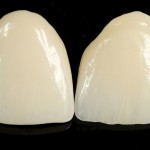
Ceramic crowns have good biocompatibility and aesthetic properties and are frequently provided restorations. Good marginal and internal adaptation of crowns is considered important for clinical success. Poor adaptation can lead to cement dissolution and microleakage and adverse clinical outcomes. Finish line configuration, cementing space, veneering process, and occurrence of cementation are factors considered to affect marginal adaptation. Of these dentists have most influence over the finish line and both rounded shoulder and chamfer have been investigated.
The aim of this review was to evaluate the influences of rounded shoulder and chamfer finish lines on the marginal and internal adaptations of ceramic crowns.
Methods
Searches were conducted in the Medline/PubMed, Embase and Web of Science databases supplemented by searches of the journals; Journal of Prosthetic Dentistry, Journal of Dental Research, Journal of Dentistry, Operative Dentistry, Clinical Oral Investigations, Journal of Oral Rehabilitation, International Journal of Prosthodontics, Journal of Prosthodontic Research, Dental Materials Journal, Journal of Prosthodontics, and Zhonghua Kou Qiang Yi Xue Za Zhi.
In-vitro studies comparing the marginal and internal adaptations of ceramic crowns with rounded shoulder and chamfer finish lines were considered. Two reviewers independently conducted the search, selected studies for inclusion extracted data and assessed study quality. A qualitative synthesis and random effects meta-analysis were carried out.
Results
- 16 in-vitro studies were included.
- Sample sizes ranged from 5-20.
- 2 studies were considered to be at low risk of bias,12 at moderate risk and 2 at high risk.
- An overall review of the data for marginal adaptation showed that 95.1% of the values measured were less than 120 µm.
- Ceramic crowns with rounded shoulders exhibited significantly better marginal adaptation than those with chamfers; mean difference [MD] = -7.8 (95%CI; -11.6 to -4.1).
- Ceramic crowns with chamfers exhibited significantly better internal adaptation than those with rounded shoulders; MD = 35.0 (95%CI; 6.5 to 63.5).
Conclusions
The authors concluded:
Ceramic crowns with chamfer finish lines showed wider marginal gaps than those with rounded shoulder finish lines MD= −7.8( 95%CI; −11.6 to −4.1).
Ceramic crowns with rounded shoulder finish lines showed wider internal gaps than those with chamfer finish lines MD= 35.0 (95%CI; 6.5 to 63.5).
Comments
This review of in-vitro studies searched a good range of databases and found that less that 5% of the included preparations had a marginal gap of more than 120 µm, a value considered by some to be the maximum tolerable. However, the studies are small involving only 150 restorations in the 16 included studies with only 2 considered to be of high quality. As the reviewers point out the review did not consider the effect of the cement space which was subject to wide variability. It is also important to highlight that the included studies are all conducted in a non-clinical environment so while they give some indication of clinical performance this may not translate directly into the clinical environment so the findings should be treated cautiously.
Links
Primary Paper
Yu H, Chen YH, Cheng H, Sawase T. Finish-line designs for ceramic crowns: A systematic review and meta-analysis. J Prosthet Dent. 2019 Feb 16. pii: S0022-3913(18)30918-1. doi: 10.1016/j.prosdent.2018.10.002. [Epub ahead of print] Review. PubMed PMID: 30782459.
Other references
Dental Elf – 25th Mar 2015
